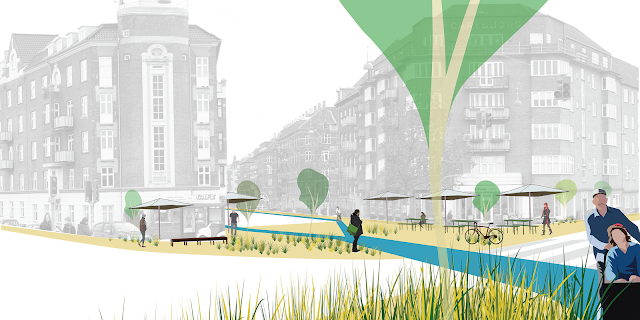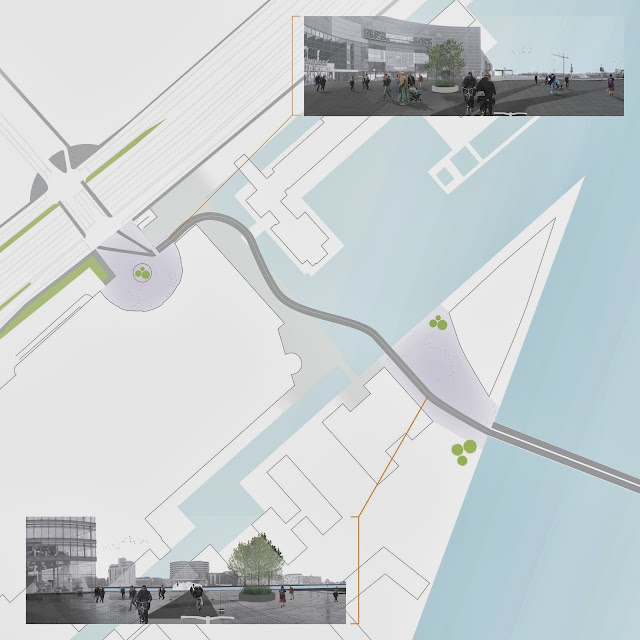
Mikael, on behalf of Copenhagenize Design Co., is a teacher in the Bicycle Urbanism Studio led by urban liveability expert Bianca Hermansen at the Danish Institute for Study Abroad (DIS). Since 1959, DIS has given American students the chance to study in Denmark. Our Bicycle Urbanism Studio features American architecture students.
Mikael led a portion of the course involving a massive Desire Lines analysis of two intersections at either end of the Dybbøls Bridge in the Vesterbro neighbourhood. The students' final project was broader than that. They were given the task of rethinking the entire area. The wide swathe of unused railyards, access to the harbour and bicycle traffic through the area.
Working with the students was brilliant and inspiring. Mikael was also an external examiner on the final projects at DIS. We thought it worthwhile to get the students to present their projects in short form. Showing off their abilities, ideas and visions. We'll divide them up into two articles. Here's the first one.
Many of the students mention "Bicycle Snake - Cykelslangen". This refers to the coming elevated cycle track in the area. Here's a map of the area in question.

BEN ZÜNKELER - I Live CPH
Site Observations:
With 55% of Copenhageners commuting to work by bicycle (a number that is increasing every year) it is undeniable that investment in bike infrastructure is necessary and beneficial. However, these ventures cannot come at the cost of overlooking the communities in which they are implemented. While separated from the harbor front by the s-tog lines and abandoned space, Vesterbro is a thriving, young, diverse neighborhood that stands to be further connected to the greater Copenhagen area and Amager by the imminent construction of the Bicycle Snake (Cykelslangen).Research and Implementation Methods:
By observing cyclist patterns, interviewing residents, and analyzing current neighborhood fabric and other neighborhood initiatives throughout Copenhagen, we identified points of conflict and potential and used these to formulate design solutions, ranging from specific infrastructure simplifications to an ambitious vision of the potential of the area as a sustainable and livable community. Overall the suggestions strive to keep in mind the fact that the modern Copenhagener experiences his neighborhood primarily on foot, on bike, or as a user of public transportation.On Foot Observations:
Three main topics emerged from interviews of commuters at the Dybbolsbro S-tog station about their “favorite part of the Islands Brygge/Vesterbro area” and “what one thing they thought that the area could use”. The love of the harbor and water in Islands Brygge was evident from suggestions to bring some aspect of the waterfront into the area. A desire for more and all-year-round sports facilities was prevalent in the younger residents. Most frequent (among pedestrians and bike users alike) was the request for more green and a greater connection to nature. All of these wishes are supported by previous and contemporary initiatives including the immensely successful harbor baths, the positive introduction of play/exercise areas such as Superkilen and Banana Park into previously undervalued areas, and the climate resilient initiatives in neighborhoods such as St. Kjeld.On Foot Solutions:
Opening up the currently unused area next to the rail tracks to the harbor and creating a gentle slope that brings pedestrians to the level of Vesterbro would extend the pedestrian realm continuously from the harbor into the neighborhood. Linking these two dynamic areas in this way would not only gain a valuable green area (with potential for both programed and spontaneous activity), but would provide pedestrians and local bikers with an alternative to the commuter infrastructure, while still making the space visible and convenient for bikers coming from farther distances. The proposal looks toward a future when the car traffic through the area will become residential and the perceived need for the disruptive and unsustainable multi-lane highway that cuts through the area will be overshadowed by the potential for positive community space.
On the bicycle Observations:
In our research we confirmed that a large number of cyclists already use the intersections at the entrance to Vesterbro and in front of Fisketorvet and predict that the numbers will increase with the introduction of the Cycle Snake. The behavior of cyclists who broke or bent the rules at these intersections (20-30% during our rush-hour observations) was used as a basis for suggested improvements in safety and efficiency of the intersection.Bicycle Ease of Use:
Between 8:00 and 9:00, near Vesterbro, cyclists bend and break the rules in an effort to find a faster route from the corner of Vesterbro to the metro station side. A Barnes Intersection is proposed to streamline the bicycle route and coordinate with the green wave. The morning crossing behavior is even more pronounced and reckless in the evening as cyclists come back from work or university. Green corners and up-lighting are proposed to protect bikers and pedestrians by coordinating traffic through the intersection.Bicycle Safety:
At the Fisketorvet intersection, cyclists frequently turn left (as a car would) and cross traffic to save time and avoid the inconvenient roundabout. In order to avoid this dangerous situation, the roundabout is removed making the route more direct and the upper entrance of Fisketorvet a bicycle centered area (referencing the boost in revenue that was experienced in Nørrebro as a result of increased bike thoroughfare and parking). In the evening (the 17:00 to 18:00 rush hour), cyclists become more reckless and deviate from their prescribed path to find the fastest way home. To keep bikes together and off of the sidewalks, a wider, bi-directional route is created to the East with the intention of eventually closing the ramps to the East to car traffic.By Train Observations:
The Dybbolsbro S-Tog station is currently underwhelming considering that it is the main hub used by the residents of Vesterbro and by those visiting the hip new area. The lack of consideration given to bikes (inconvenient/inadequate parking space, lack of even the traditional wheel channels on the stairs, and poor access for the bicycle commuters coming from the Vesterbro neighborhood) will only become more prevalent with the completion of the Cycle Snake. Additionally, the space platforms are drab and overshadowed by the bridge and vast surrounding area. By Train Solutions: If the language proposed for the new park is continued into the station, convenient, green ramps will replace the existing stairs and also act as bio-swales to mitigate the water runoff from the surrounding hardscape. To complete the rebranding of the station as an example of climate and neighborhood conscious design, it should be renamed “Vesterbro Station”. In considering all three scales of movement (walking, biking, and public transport) and three perspectives of intervention (infrastructure, livability, and sustainability) people-conscious communities can be created.
By Train Solutions: If the language proposed for the new park is continued into the station, convenient, green ramps will replace the existing stairs and also act as bio-swales to mitigate the water runoff from the surrounding hardscape. To complete the rebranding of the station as an example of climate and neighborhood conscious design, it should be renamed “Vesterbro Station”. In considering all three scales of movement (walking, biking, and public transport) and three perspectives of intervention (infrastructure, livability, and sustainability) people-conscious communities can be created.
JEANNETTE MUNDY

The young development near the water lacks the history and urban fabric of typical Copenhagen neighborhoods. To bring an identity to the area, the street typology of Vesterbro extends to the harbor and is recontextualized to respond to the water. Bikers can efficiently circulate through the site with added infrastructure allowing for smoothly curved corners and a ramp to replace the stairs. In addition, the inward facing mall opens onto the outside to mimic a Vesterbro commercial street.
ANNA DARLING

As Copenhagen city strives to improve the connection between Vesterbro and Islands Brygge it is heavily investing in infrastructural improvements for cyclists, namely, the new Bicycle Snake. However, as the snake is currently being built, what remains uncertain is how the new cyclists will navigate the existing transitions on and off the snake.
Our twelve-hour study of the intersection outside of Fisketorvet Mall led us to identify potential cycle snake users, based on those who currently use the stairs and parking ramp. Our observation identified approximately 3,000 people who would be using the cycle snake; a number that is certain to grow once the snake is completed.
This proposal redesigns the spaces leading up to the cycle snake to accommodate the increasing number of bikers as well as pedestrians. Outside the Fisketorvet Mall, the space would be closed to car traffic, allowing pedestrians and bikers more space to travel along their desired paths. Car traffic into the mall would then be redirected to the southwestern parking entrance. Closing the roundabout to car traffic opens the space for public occupation and new programs.
Similarly, the connection from the cycle snake to Brygge Broen would be more clearly defined by a specific bike lane. Improvements such as bike-scale lighting and vegetation to provide wind protection would serve to improve the cycle route.




